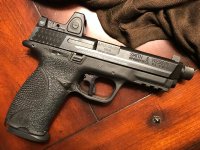You've received a lot of good advice above. Since you have a compact, I guess that you might be interested in concealment. This presents a major problem as you're about to raise the effective height of your slide considerably. This can make concealment very difficult, to say nothing of the issues in finding a holster that will accept an optic and be concealable. Many of the optic ready holsters are "IDPA accepted" or words to that effect. Loosely translated, that means it'll conceal-wink, wink, nudge, nudge-under a garment made for someone 50 or so pounds heavier than you are. It won't be real world concealed.
Depending upon your level experience and training, finding the dot quickly can be an issue, but with a lot of practice, you can learn to do it. There are some optics out there that are smaller than others. You don't want an optic much larger (wider) than the slide, but the itty, bitty optics also often have an itty, bitty field of view which can be an issue trying to find the dot.
Finally, the major benefit of the optic is at ranges of about 20 yards and out. The average private citizen defensive altercation is at about 5 yards.

